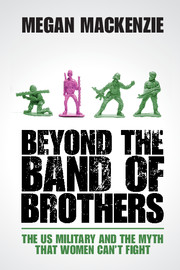Book contents
- Frontmatter
- Dedication
- Contents
- List of tables
- Acknowledgments
- Introduction: myths, men, and policy making
- 1 The combat exclusion is a story we tell ourselves … about men
- 2 The disintegration of the combat exclusion in Iraq and Afghanistan
- 3 It just doesn't feel right: emotion and the combat exclusion policy
- 4 Faster, stronger, more male: women and the failure of physical standards
- 5 Sex, cohesion, and national security
- 6 Using online debates to map public reaction to the combat exclusion
- Conclusion
- Bibliography
- Index
Introduction: myths, men, and policy making
Published online by Cambridge University Press: 05 July 2015
- Frontmatter
- Dedication
- Contents
- List of tables
- Acknowledgments
- Introduction: myths, men, and policy making
- 1 The combat exclusion is a story we tell ourselves … about men
- 2 The disintegration of the combat exclusion in Iraq and Afghanistan
- 3 It just doesn't feel right: emotion and the combat exclusion policy
- 4 Faster, stronger, more male: women and the failure of physical standards
- 5 Sex, cohesion, and national security
- 6 Using online debates to map public reaction to the combat exclusion
- Conclusion
- Bibliography
- Index
Summary
From this day to the ending of the world,
But we in it shall be remember'd;
We few, we happy few, we band of brothers;
For he to-day that sheds his blood with me
Shall be my brother; be he ne'er so vile,
This day shall gentle his condition:
And gentlemen in England now a-bed
Shall think themselves accursed they were not here,
And hold their manhoods cheap whiles any speaks
That fought with us upon Saint Crispin's day.
Shakespeare, Henry V, 1598The male combat unit lies at the heart of American military identity. The story of a group of men risking their lives to violently defend the United States has been a consistent national narrative. “Bands of brothers,” “comrades in arms,” and “a few good men” are examples of well-worn tropes that signal men's unique connection to one another and their ability to overcome extreme odds to protect the nation. According to military historian Martin van Creveld, war is “the highest proof of manhood” and combat is “the supreme assertion of masculinity.” In his Afghanistan war memoir, US Army Infantry Officer Andrew Exum described the infantry as “one of the last places where that most endangered of species, the alpha male, can feel at home.” These accounts of soldiering depict male troops as the natural and rightful protectors of society.
In contrast, women are often seen as potential spoilers to military culture. There are fears that the integration of women into the military – particularly into combat roles – “feminizes” and weakens the military. Stephanie Gutmann explains, “I do not think we could have a capable integrated combat arms without real androgyny, without real suppression of male and female qualities.” Such portrayals of the military imply that restricting women from the front lines of war is essential to national security. This rationale was at the heart of the combat exclusion – a US military policy designed to keep women from combat units.
- Type
- Chapter
- Information
- Beyond the Band of BrothersThe US Military and the Myth that Women Can't Fight, pp. 1 - 18Publisher: Cambridge University PressPrint publication year: 2015



